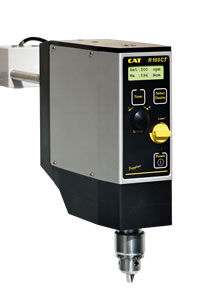Tips on Selecting a High Performance Overhead Stirrer
Overhead stirrers are highly popular mixing instruments used to blend ingredients in research laboratories and pilot plants. These units operate by means of motor-powered impellers of different configurations that perform the mixing operation. Being motor powered they can handle samples of higher viscosity than standard or hotplate magnetic stirrers operated with a different technology. In this post we take an in-depth look on selecting a high performance overhead stirrer.
Using the CAT R100CT as an example we’ll examine
- Typical applications for a high performance overhead stirrer
- Features to look for in these stirrers
- Data-collection capability
- How to simultaneously operate multiple stirrer systems
We hope you will find the information useful in making your purchasing decision.
When You Need a High Performance Overhead Stirrer
Determining needed laboratory and pilot plant overhead stirrer features and benefits is a first step in setting up your purchasing specifications. There are four key considerations. All must be considered in one order or another:
- mixing speed
- motor power
- processing capabilities and
- programmable control functions
Money spent in an overhead mixer will be money wasted if the model you selected cannot perform the job. Our post on mini overhead stirrers looked at entry level models; here we will explore the features available to researchers who need more extensive performance and control parameters.
A Snapshot of CAT Scientific’s R100CT Pilot Plant Overhead Stirrer
CAT’s R100CT overhead stirrer is designed for use in chemical and biological laboratories of industrial enterprises, universities and pharmacies. It can be used for pilot plant applications processing samples up to 200 liters.
These powerful mixing units come with a mounting stand and a silent-drive 220-watt high-performance brush motor that provides up to 600 Ncm torque energy to process medium and high viscous materials (10,000 to 100,000 mPa.s).
Stirring speeds can be precisely controlled between 50 and 500 rpm with higher speeds available on order. A soft start/stop feature keeps samples from splattering out of the beaker or flask.
Researchers will appreciate the R100CT simplicity of operation exemplified by the intuitive control panel.
- An incremental encoder wheel is used to set up operating and timing from 1 minute to 99 days. A separate LED illuminates when the timer is active.
- The On/Off button has an LED indicating when the system is on.
- Set the stirring speed with the speed control knob.
The adjacent Load LED will illuminate if the unit is not able to hold set motor speed due to too high torque. Under this condition the unit will automatically reduce the motor speed so that the maximum allowed motor torque is not exceeded and burnout is avoided. The unit will also shut down if the impeller is blocked.
- The dual-level liquid crystal display shows all relevant systems data such as set and real values of speed, torque, time and power output.
- Accessing this information is achieved by pressing the panel’s display select button to alternate between various functions.
As with all CAT overhead stirrers the R100CT pilot plant stirrer self tests to protect against overload and overheating, and can be paired with a variety of stirrer impellers as described in our post on the topic.
Data Collection
At the back of the fan-cooled control operating panel of the CAT R100CT is the 9-pole sub-D connector for the full duplex RS-232 interface to allow remote operation as well as the collection of speed, torque and power data.
GLP record keeping is supported by full remote access of all stirrer functions (read and write). Multiple units of overhead and magnetic stirrers, bottle-top burettes, micro-metering pumps and similar equipment can be connected using the proprietary CAT “Shake and Stir” software .
This is accomplished by assigning different “slave” addresses to each unit connected to a computer thereby enabling the computer to access each unit individually.
In brief, it is a Windows-based PC program with comprehensive user interfaces provides researchers the option of manually or automatically controlling overhead stirrers.
When installed it shows a collapsible split-screen display. On the left the researcher enters data for each of the stirrers to be managed by the software, the top half of which is for manual control and the bottom half for automated control.
For more information on this time-saving system to operate multiple lab instruments see our post on the CAT Shake and Stir software. This focuses on magnetic hotplate stirrers but the same principle applies.
Need More Info?
Complete details on this high-level overhead stirrer can be found in the operations manual or by contacting us for further information.

The CAT R100CT Pilot Plant Overhead Stirrer control panel
